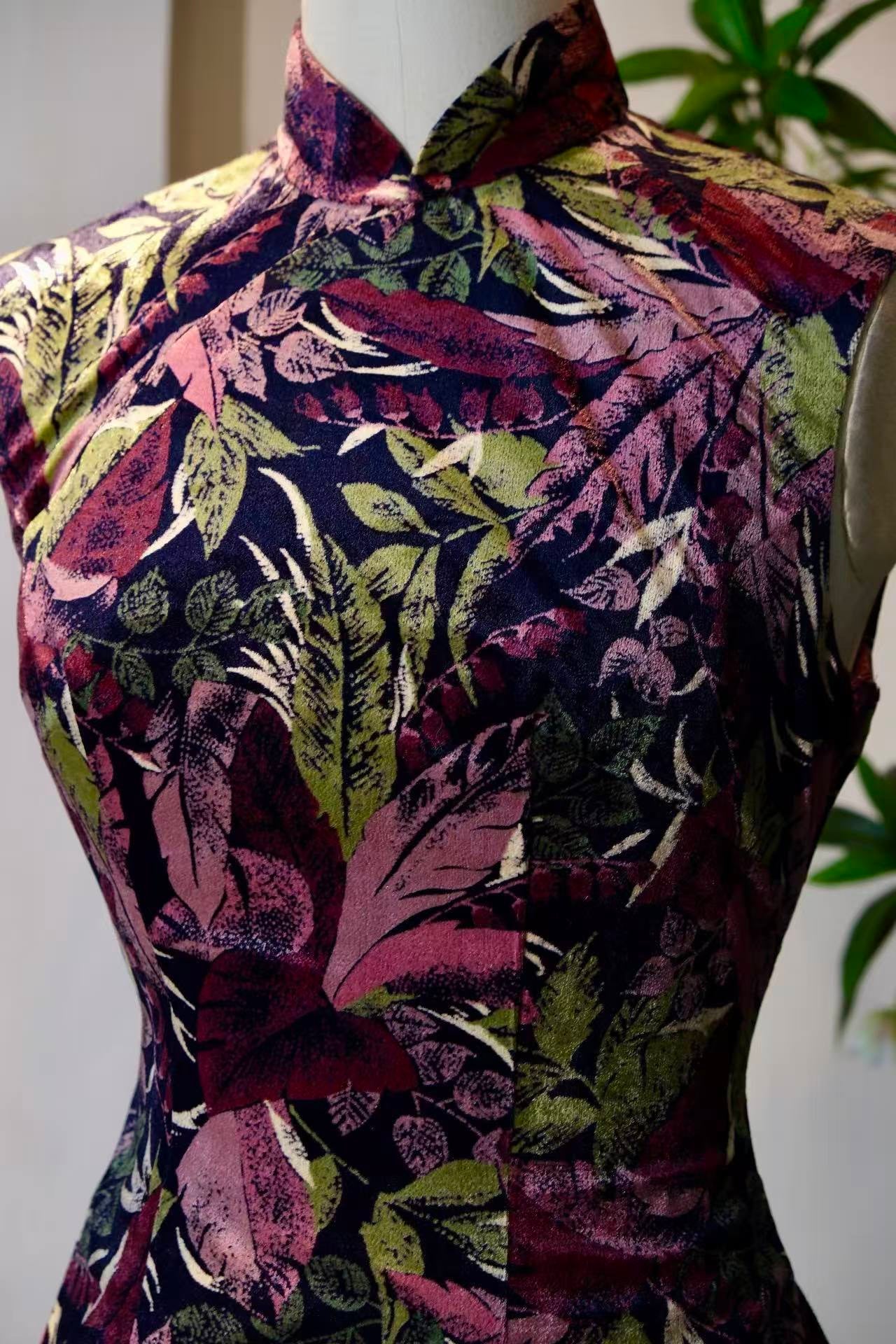深圳溯源
60年代 - 上世纪六十年代南洋风热带植物丝绒印花古董港式旗袍 | 1960s - An Antique Hong Kong-style Cheongsam from the 1960s, Featuring a Southeast Asian-inspired Tropical Plant Velvet Print
60年代 - 上世纪六十年代南洋风热带植物丝绒印花古董港式旗袍 | 1960s - An Antique Hong Kong-style Cheongsam from the 1960s, Featuring a Southeast Asian-inspired Tropical Plant Velvet Print
无法加载取货服务可用情况
分享一件上世纪六十年代南洋风热带植物丝绒印花古董港式旗袍。
旗袍主体以深绛色丝绒为基底,其上铺陈的热带植物纹样———
若将二十世纪香港旗袍史视为一条奔流的长河,六十年代恰是其“
六十年代丝绒多依赖英国进口,“重缎丝绒”
今日再看这件旗袍,它已非单纯的衣装,而是半个多世纪前香港“
This is a deep dive into an Antique Hong Kong-style Qipao from the 1960s, featuring a striking tropical botanical silk velvet print with a distinct Nanyang (Southeast Asian) flair.
The body of the Qipao is based on a deep Garnet Red (or deep crimson) silk velvet, upon which an arresting tropical botanical motif is spread: the veins of banana leaves, like strokes of emerald ink, cut vertically across the light, their serrated edges seemingly gnawed by the sea breeze and edged in gold. Interspersed among the leaves, clusters of Kapok flowers burn like crimson flames, their petals layered one upon the other, the central stamen vaguely visible within the velvet folds. In the middle section of the pattern, the fronds of a tropical fern are rendered using the 'Fading Technique' (退晕法), creating a gradual, washed-out gradient from vibrant jade green to pale grey, successfully replicating the dew-kissed, layered transitions of foliage in the morning mist of the rainforest.
If one views the history of the 20th-century Hong Kong Qipao as a flowing river, the 1960s mark its majestic turning point—a point where it began to embrace all sources. The design language of this particular Qipao, while evolving from the traditional Shanghai style of "diagonal closure and pankou knots," reveals subtle nuances of Nanyang cultural infusion in its details. This stylistic shift is inextricably linked to Hong Kong's status in the 1960s as a "trade hub for the South Seas." As tropical flowers from Southeast Asia, vegetable dyes from India, and Western three-dimensional tailoring patterns converged here, the Qipao transitioned from a "boudoir emblem of Shanghai socialites" to a "social uniform for Nanyang comprador heiresses." The banana and Kapok motifs on the fabric are not mere natural elements but cultural metaphors for Hong Kong as a "tropical colonial port": they embody both the classical softness described in ancient Chinese poetry and the modern vitality of the "tropical blooms worn on the headscarves of dock workers" reported in contemporary newspapers.
In the 1960s, the heavy-weight silk velvet was often imported from the UK. "Heavy-weight satin velvet" was particularly rare due to its warp and weft density reaching 1200 threads per square inch, with extremely low output. Furthermore, such velvet is susceptible to mildew in humid conditions. Its ability to remain in this state—"pile intact and free from moth damage"—after half a century, required a perfect confluence of circumstances. After the 1960s, the Hong Kong Qipao rapidly declined due to the rise of synthetic nylon fabrics and the popularity of the mini-skirt. The production cycle for this style of "heavy velvet labor-intensive print" lasted no more than five years, making its surviving quantity significantly rarer than the mass-produced items of the 1980s.
Viewing this Qipao today, it is more than just an item of clothing; it is a microcosm of Hong Kong's "Nanyang trade" and "cultural melting pot" from over half a century ago. Within the veins of the banana leaves on the velvet, the tides of Victoria Harbour seem still to flow; within the golden threads of the Kapok stamen, the jazz music of Lan Kwai Fong dance halls seems to be sealed. As it unfurls once more under the light, the creases smoothed by time conceal a "tropical botanical poem" written by a generation of women, using fabric as their pen on the scroll of history—they used their curves as the stem and their colors as the leaves, living their lives as Kapok flowers that would never fade in the winds of change.
分享


























